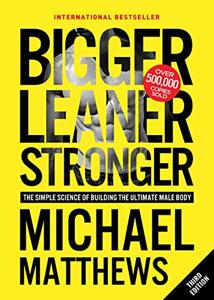
Want to learn the ideas in Bigger Leaner Stronger better than ever? Read the world’s #1 book summary of Bigger Leaner Stronger by Michael Matthews here.
Read a brief 1-Page Summary or watch video summaries curated by our expert team. Note: this book guide is not affiliated with or endorsed by the publisher or author, and we always encourage you to purchase and read the full book.
Video Summaries of Bigger Leaner Stronger
We’ve scoured the Internet for the very best videos on Bigger Leaner Stronger, from high-quality videos summaries to interviews or commentary by Michael Matthews.
1-Page Summary of Bigger Leaner Stronger
Overview
This book is about losing fat and building muscle. It also tells you how to create a healthier lifestyle through diet and exercise.
Fad diets, workout regimens, and endless supplements are often ineffective for building the ideal body. They’re also not based on hard science and don’t deliver on their promises. The Bigger Leaner Stronger plan is different because it’s based on scientific studies and proven methods that work across age groups.
The plan is simple and effective. The diet focuses on nutrient counts, as opposed to restricting certain foods that the dieter can eat. This makes it easier for someone to build muscle and burn fat without spending hours at the gym every day or wasting money on worthless supplements with misleading labels. It also allows a person to develop sustainable habits because they see results quickly, which motivates them to keep trying new things.
Key Takeaways
Many men struggle to lose weight because they follow diets, workout routines, and supplements that are not rooted in science.
Progressive tension overload is important for building muscle. This principle is a fundamental component of the Bigger Leaner Stronger program, which focuses on building muscle and reducing fat. The key to achieving an ideal male physique is bulking and cutting by eating properly before workouts and after them while exercising regularly.
Free weights and heavy weightlifting are necessary to build muscle. Performing fewer repetitions with more weight is better for building muscle than the widely touted method of performing many reps with lighter weights. While excessive cardio can cause muscle loss, moderate amounts of cardio done properly can help build more muscle over time.
It’s important to track progress while following the Bigger Leaner Stronger program.
Key Takeaway 1: Many men struggle to lose weight and build the ideal body because they follow fad diets, workout routines, and supplements. Most of these are not rooted in hard science, so they are ineffective.
Analyze
Many health and fitness magazines are sponsored by supplement companies, so they may have a bias in their content. Most of the articles and advertising aren’t meant to inform readers about science-based regimens; rather, they’re designed to sell products. However, these magazines are often people’s primary source for diet and exercise knowledge. To keep readers hooked on reading them every month, the magazines introduce new fad diets or trendy training methods in each issue. Although many of these fads haven’t been proven through reliable scientific studies to be effective for fat loss or muscle gain, men continue trying them because they hope that something will work eventually.
What these fitness magazines don’t tell you is that professional bodybuilders may die prematurely. They put too much strain on their bodies, which could be why they’re unhealthy and have diet related illnesses more than the average American citizen. If people knew this, then maybe they wouldn’t trust these magazines as much or buy their products because of a lack of faith in them. This would make it easier for plans like Bigger Leaner Stronger to get into the market by using strong science to help people achieve an ideal male body with large muscles and low levels of fat.
Key Takeaway 2: Progressive tension overload is the key to building an impressive musculature and a fundamental component of the Bigger Leaner Stronger program.
Progressive tension overload means lifting more weight over time, which increases the tension in muscle fibers. This is what causes muscles to grow larger and stronger so they can withstand heavier weights. If you don’t keep adding weight to the bars you lift, no amount of proper dieting and exercise will build muscle like progressive overload does. You should be increasing your reps or adding a little bit more weight from last week’s workout to ensure that you are constantly encouraging muscle growth.





